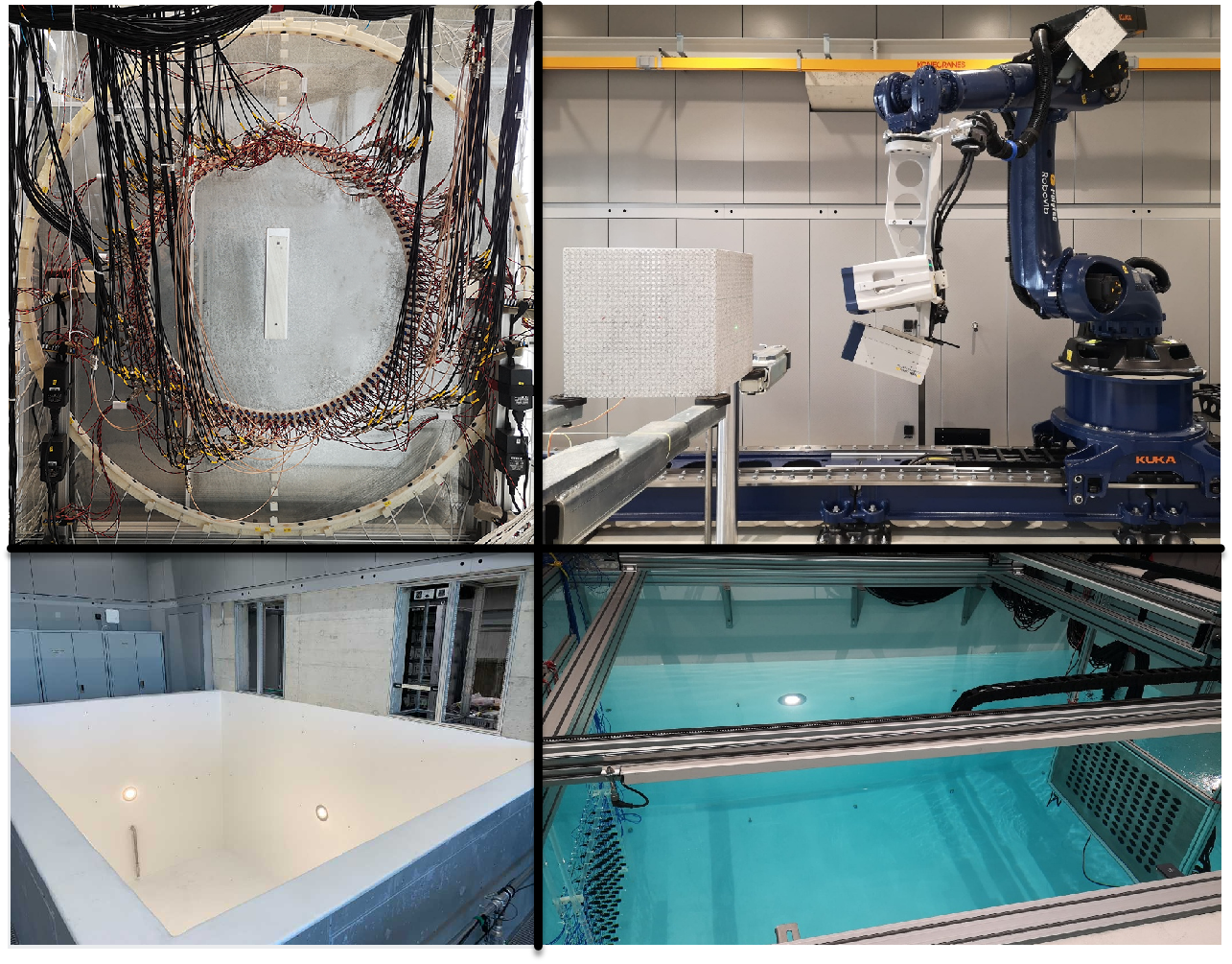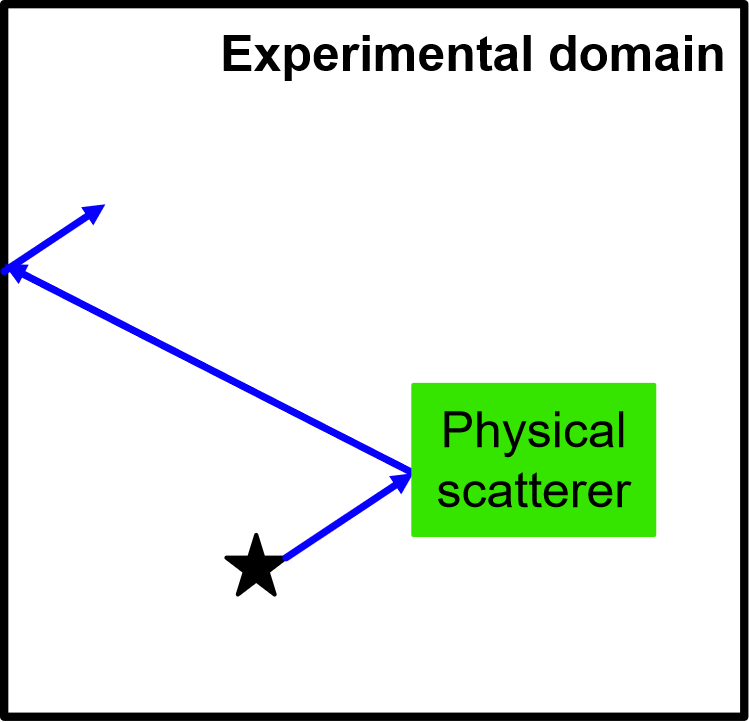Immersive Wave Experimentation (IWE): Cloaking, Holography, and Cloning
If you have ever clapped in a small room or dropped a pebble in a bucket, you know the problem: waves bounce off the boundaries. In a real ocean, a quiet field, or outer space, waves can radiate away seemingly “to infinity.” In a lab, they hit walls and come right back. Those echoes contaminate measurements, shrink the space where we can trust the results, and make it hard to study how waves actually behave in the wild.
We decided not to fight that limitation with bigger rooms or thicker foam. Instead, we taught the walls to help. Our approach blends a physical experiment with a virtual world in real time. We call this Immersive Boundary Conditions (IBCs). Think of it as a portal: the lab stays small, but the waves inside it “believe” they are in an unbounded environment because the boundaries actively behave as if the outside extends forever. IBC let us switch off a lab’s walls, make objects acoustically invisible, project virtual objects into reality, and even clone the scattering fingerprint of anything we like—on demand and across a broad range of frequencies. For more details, see Centre for Immersive Wave Experimentation

1) The challenge: small labs, bouncing waves
In the wild—open water, the sky, or space—waves radiate away and their energy leaves the scene, but in tanks, rooms, and waveguides they ricochet off walls, polluting measurements and burying subtle effects like weak scattering or fine phase shifts. Anechoic chambers try to tame those echoes with foam wedges, yet their effectiveness collapses at low frequency because the wedge depth must scale with wavelength, making low‑kHz setups impractically large; in solid 3D volumes for full elastic P–S studies, operating around 1–20 kHz means wavelengths approach the sample size, so boundary energy can dominate the interior wavefield. Reduced‑size labs (kHz acoustics, plates, rooms, waveguides) thus suffer reflections that mask the very scattering we want to observe; passive absorbers are bulky and narrowband, while classic active cancellation degrades off‑axis and at higher frequencies. This is compounded by a scale gap: seismology and many field scenarios live below ~100 Hz, whereas conventional lab acoustics often push to hundreds of kHz or MHz to keep echoes at bay, making it hard to transfer insights—especially for frequency‑dependent phenomena like attenuation, dispersion, anisotropy, and nonlinearity that do not upscale reliably.

Size limitation causes wall-boundary reflections and restricts the natural propagation of waves.
Laboratories often suffer because their size is too small to simulate natural, non-boundary wave propagation. As shown, these boundary reflections strongly interfere with the interior experimental domain where scattering is being studied.
Related: Elastic immersive wave experimentation – Doctoral Thesis, ETH Zurich, 2022.
2) Immersive Boundary Conditions: Active Wave Energy Cancellation
In size-limited laboratories, reflections from rigid boundaries often obscure the waves scattered by interior objects. One elegant solution is the deployment of active sources around the physical experimental domain. These active sources are designed not only to generate waves but also to cancel the naturally outgoing waves via carefully controlled emissions.
This video illustrates the concept of using active sources to cancel outgoing waves in a wave experiment.
In an ideal implementation, the active boundary sources generate counter-waves that completely cancel the outgoing wavefield. As a result, the only waves visible in the experiment are those related to the interior scatterers, free from unwanted boundary effects. This clear separation is crucial for accurate measurement and analysis.
Moreover, by emitting waves that embody the desired properties of an extended or virtual environment, the active sources seamlessly connect the physical experiment to an artificial domain. In this way, the experiment is virtually "immersed" into a much larger space where the propagation characteristics are as if no rigid boundaries were present. In effect, the physical wave propagation mirrors the behavior of waves in an idealized, boundary-free environment.
Simulation movies of this approach vividly demonstrate that when active cancellation is implemented, the laboratory’s limited physical dimensions give way to an immersive experimental domain — one that accurately represents the real-world scattering phenomena and enables broadband measurements free from reflection-induced artefacts.
2) Immersive Boundary Conditions (IBCs): real-time, broadband coupling
IBCs let us virtually replace what lies beyond a control surface. Measured pressure/velocity on an outer recording ring are extrapolated in real time to an inner emitting ring; sources on that inner ring then inject the numerically predicted field back into the lab. With low-latency FPGAs (~200 μs compute in air; ~870 μs total budget for a ~30 cm ring spacing), waves pass seamlessly between physical and virtual worlds, enabling absorbing, cloaking, and holography behaviors without knowing the incident field a priori.
- Key idea: use representation theorems + precomputed Green’s functions as “wave kernels” for the extrapolation.
- Why it matters: deterministic, broadband, and global control — no tuning to a single frequency or angle.


Related: Becker et al., Science Advances, 2021; Becker et al., PRX, 2018.
3) Going elastic: an iterative IBC with only surface data
For elastic media, we cannot rely on ultra-low-latency direct control at scale. Instead, we devised an iterative method that: (1) records on a closed free surface, (2) separates ingoing/outgoing constituents, (3) computes physical-to-virtual interactions, and (4) applies them via boundary sources with windowing to converge to an immersed state. No interior access, no need to know the solid’s interior — yet we synthesize physical–virtual interactions and cancel primaries.
- Contribution: 3D-capable elastic IBC workflow using only surface arrays (validated in 2D synthetics and lab prototypes).
- Why it matters: “infinite” elastic experiments at seismic-band frequencies in compact labs.


Key paper: Li, X., Robertsson, J., and van Manen, D.-J., Elastic immersive wave experimentation, GJI, 2023.
4) Removing boundary artefacts: Multidimensional Deconvolution (MDD)
citate MDD from other research story On top of that, we use a technique called Multi-Dimensional Deconvolution (MDD) to transform messy, echo-laden measurements into the clean, physically correct responses you would get in open space. Together, Rigid lab walls inject endless reverberation. With MDD we post-process recordings on a closed surface to retrieve the free-space scattering Green’s functions of interior objects — exactly as if the boundary were transparent. The method is purely data-driven: no source wavelet, no boundary characterization, no interior model needed. We separate the wavefield on arbitrary curved, closed arrays using a local wavenumber method, then invert the convolutional system across many illuminations.
- Contribution: Closed-aperture unbounded acoustics via MDD; “radiation-condition” data for any interior scatterer.
- Why it matters: supplies the correct kernels for holography and for cloning.


Key paper: Li, X., Becker, T., Ravasi, M., Robertsson, J., and van Manen, D.-J., Closed-aperture unbounded acoustics experimentation using multidimensional deconvolution, JASA, 2021.
5) Cloaking in the lab: broadband, real-time, no prior source knowledge
With IBCs we rendered a rigid scatterer invisible inside a 2D waveguide. The control loop extrapolates from a recording ring to a sound-hard emitting ring and cancels all scattering, including multiples from the lab boundary. No a priori knowledge of the incident field is needed — even moving or unknown sources are cloaked. The scattered intensity dropped by ~8 dB over 3.5 octaves.


Key paper: Becker, T. S., et al., Broadband acoustic invisibility and illusions, Science Advances, 2021.
6) Holography: virtual imprints you can measure physically
Using dual inner rings (effective monopole + dipole emission), we replay the scattered field of arbitrary virtual objects in real time. The lab sees exactly what would have been scattered by the virtual object. Think perfect on-demand illusions — switch scatterers without rebuilding hardware.


Related: van Manen et al., JASA, 2015 (theory); Börsing et al., Phys. Rev. Applied, 2019 (early experiments).
7) Cloning: acquire a digital twin, then bring it back to life
Cloning is a simple two-step process:
- Acquire: illuminate a real scatterer placed inside a closed receiver aperture and use MDD to retrieve its scattering Green’s functions under radiation conditions (free of boundary imprint).
- Replay: remove the object; use immersive holography to extrapolate from the outer ring to the inner ring and drive the sources so that the lab field scatters exactly as if the object were present — for any incident broadband wavefield, all orders included.
Because the twin is digital, we can augment it: translate/rotate it, scale its response, or even add non-physical gain/transparency.




Key paper: Müller, J., Becker, T. S., Li, X., et al., Acoustic cloning, Phys. Rev. Applied, 2023.
8) Where this goes next
- Mix real and virtual scattering to prototype metamaterials and digital twins rapidly.
- Car audio: local immersive zones per passenger, dynamically “reshaping” cabin acoustics.
- Education and entertainment: VR room acoustics you can measure and feel in real time.
- Bigger rooms, deeper frequencies: modular 3D prototypes (e.g., 2.7 m × 3.1 m × 4.5 m) and scalable arrays.
Key papers
- Müller, J., Becker, T. S., Li, X., et al. Acoustic cloning. Phys. Rev. Applied 20, 064014 (2023). DOI
- Li, X., Becker, T., Ravasi, M., Robertsson, J., and van Manen, D.-J. Closed-aperture unbounded acoustics experimentation using multidimensional deconvolution. JASA 149, 1813–1828 (2021). DOI
- Becker, T. S., van Manen, D.-J., et al. Broadband acoustic invisibility and illusions. Science Advances 7, eabi9627 (2021). DOI
- Li, X., Robertsson, J., and van Manen, D.-J. Elastic immersive wave experimentation. GJI (2023). DOI
- Becker, T. S., et al. Immersive wave propagation experimentation. Phys. Rev. X 8, 031011 (2018). DOI

